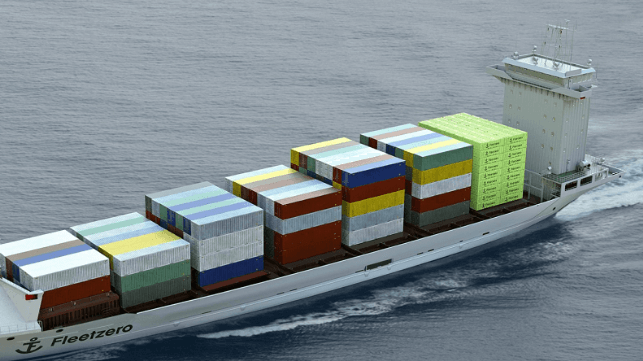New Orleans Startup Seeks to Develop Swappable-Battery Electric Ships

A duo of graduates from the US Merchant Marine Academy have started a company called Fleetzero, which plans to build battery-electric ships that sail between nearby major ports. Plans call for offloading of containers of freight and nearly depleted batteries, then taking aboard replacement containers of freight and freshly recharged batteries. With this method, ships could carry a comparatively small battery bank.
Introduction
Governments around the world have been putting pressure on the commercial maritime sector to reduce carbon emissions. The development of grid-scale battery technologies that can be housed within standard size shipping containers has provided opportunity to adapt such battery technologies for ship propulsion.
While container-based batteries are unsuitable for road vehicle propulsion and have limited application in railway propulsion, the scale of maritime technology is compatible with container-based electrical energy storage. Large-scale commercial maritime vessels offer both the volumetric space to carry an array of container batteries and capacity to carry the weight of such batteries. Several competing companies offer grid-scale batteries and electrical energy storage systems designed to be housed inside standard shipping containers.
Proprietary Battery Container
Fleetzero is developing their own unique battery of 2 MWh capacity, housed in a low-height container of 20 feet by five feet with a weight of eight tonnes. Their battery uses improved lithium-iron-phosphate (LFP) chemistry, which is less susceptible to heat build-up. The battery is designed to be rugged and withstand abuse. Fleetzero plans to manufacture the improved LFP battery domestically in the USA at a facility located in Birmingham, Alabama, with initial application in American vessels.
Operational plans call for replacement of containers of discharged batteries at various ports-of-call, with containers of recharged batteries. Fleetzero advises that their container battery system has received approval for vessel propulsion from the American Bureau of Shipping (ABS).
Advances in lithium iron-phosphate batteries include reduced risk of heat build-up along with extended life expectancy at 50 percent and 80 percent depths of discharge. Some newer versions of the batteries can achieve 3,500 to 5,000-cycles at 80 percent depth of discharge. Batteries would likely undergo up to 350 deep-cycle recharges per year in maritime propulsive application, translating to at least 10 years of service when compensation for gradual reduction in storage capacity over time. In such operation, vessels would replace batteries every 12 hours with recharge involving up to 10 hours.
Power, Speed and Distance
A ship designed to carry 1,500-TEU might require 25,000 kW of engine power to propel the ship at a speed of 25 knots. Slowing the ship to half that speed would reduce power requirement by a factor of eight. Compensating for reduced propeller propulsive efficiency could translate to 5,000 kW at 12.5-knots sailing speed. If the ship were to sail for 30 hours at 12.5 knots, it would require an energy storage capacity of 150,000 kWh. An array of 100 containers of lithium iron-phosphate batteries 200,00 0kWh could undertake the voyage with batteries operated to 80 percent depth of discharge.
Containers of recharged batteries would be ready at port upon arrival of a ship. It may or may not exchange revenue containers before sailing to another port.
Instead of carrying containers of batteries onboard ship, the ship might tow a small barge laden with containers of batteries, allowing for exchange of a barge laden with containers of recharged batteries at various ports-of-call. Such operation would have potential to be viable along high-density shipping lanes where multiple ships would briefly stop to exchange containers of batteries.
Inland waterways
There would be opportunity for battery-electric tugs to push and navigate barge tows along navigable inland waterways, with potential for a pair of battery-barges to be placed on either side of the tug in integrated tug-barge operation. Allowing room for lock passage, each battery barge could carry seven TEU lengthwise by four TEU widthwise, for a maximum of 56 containers of batteries.
With two battery barges, a total of 112 containers of batteries would provide up to 175,000 kWh of useable energy for propulsion. A tow requiring 2250 kW could operate for up to 75 hours at 10 knots before needing to swap nearly exhausted battery-barges for recharged battery-barges.
Oceangoing ATBs
There are several operators of ship-sized articulated tug and barge (ATB) units that navigate in coastal service. Such tug-barge combinations also sail on North America’s Upper Great Lakes. The tug would sail in the hydraulic shadow of the main barge ahead of it, allowing for operation of an extended length of tug. An extended length battery-electric tug would carry containers of batteries and designed to allow for easy exchange of nearly exhausted batteries for recharged batteries at select ports-of-call.
Conclusions
Fleetzero plans to convert a diesel vessel to container battery propulsion, using a design modification that facilitates rapid exchange of containers of nearly exhausted batteries with containers of recharged batteries. Their plans call for battery-electric propulsion involving vessels on inland waterways and in domestic coastal service. While their concept has merit and shows potential for future development, they will need to prove their concept in domestic American maritime service. Operation along America’s navigable inland waterways represents a possible area of future opportunity for battery-electric propulsion using containers of lithium iron-phosphate batteries.
The opinions expressed herein are the author's and not necessarily those of The Maritime Executive.
